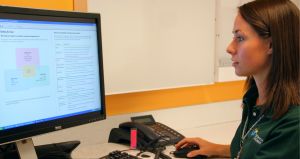According to a recent study* by the Centers for Disease Control and Prevention, a concussion sends students to the emergency room every five minutes in this country. As the new school year begins, and middle school and high school sports practices and competition kick into full action, Nationwide Children’s Hospital Sports Medicine introduces an extensive concussion awareness program – called the “Concussion ToolKit” – in which they educate parents, coaches, teachers and school administrators, along with the student-athletes themselves, about the signs, symptoms, treatment and management of concussions.
This new toolkit has a wide range of information for different groups of people who support the student-athlete both on and off the field. The toolkit bundles new brochures written for athletes, parents and coaches, as well as an updated second edition of the previously released “Concussions in the Classroom” guide for teachers. The highlight of the package is the brand new “Administrator’s Guide to Academic Concussion Management,” which is designed to help school administrators develop a communication plan in an effort to unify the response to a concussion and make sure that everyone is on the same page when it comes to getting the student-athlete better.
“When young athletes suffer a concussion, it is very important that they not only receive physical rest, but mental rest too,” explained Steevie Carzoo, ATC, a certified athletic trainer with Sports Medicine at Nationwide Children’s Hospital. “This means that the student-athletes may need accommodations that lessen the load on their brain, whether it’s in school or outside of school, to actually let them heal before stress is put back on the brain. It’s important for not only parents and coaches to understand this, but also school teachers and administrators, and the student-athletes themselves.”
No two concussions are exactly the same and individualized treatment is key. Developing brains are constantly changing, and one student-athlete’s symptoms may be completely different from another’s even if they sustain the same type of injury. While most kids will recover within a week or two, there are plenty of student-athletes who struggle for weeks, months and occasionally, even years.
Treatment for concussions needs to not only occur at home but within the classroom as well to ensure a full recovery. Abstaining from tasks that can be mentally straining will help the child in the healing process.
“We call concussions ‘silent injuries’ because if you don’t know the signs and symptoms, you can’t necessarily look at a child and know that they’ve suffered the injury,” said Steven Cuff, MD, a Sports Medicine physician at Nationwide Children’s. “To recover from a concussion, student-athletes need certain accommodations to be able to heal properly and to succeed in school. The more people we can educate about that, be it the teacher, the guidance counselor, the school nurse, the school administrator, the better off the kids are going to be and the quicker they can heal.”
A concussion is a traumatic injury to the brain. It may be caused by a blow, bump or jolt to the head or by any fall or hit that jars the brain. Common symptoms include headache, dizziness, feeling foggy or slowed down, fatigue, sensitivity to light and noise, difficulty concentrating and remembering, sleep disturbance and feeling more emotional.
If a child or adolescent suffers a concussion, doctors recommend that the parent or caregiver contact their child’s school and let them know of the child’s diagnosis. It is important for parents to discuss and develop a plan with their child’s teachers and counselors in order to help the child heal properly. The Concussion Toolkit helps parents, teachers and administrators work together to ensure the injured child gets healthy again, both on and off the field.
To view the toolkit and for additional information about concussions and other sports-related health and wellness topics, visit NationwideChildrens.org/Concussions.
Tips for working with students who suffer a concussion:
- Parents, coaches, teachers and administrators should keep in mind that the child’s physician may recommend half-day attendance or even absence from school for a certain period of time.
- Students who have suffered a concussion should avoid extensive computer use, texting, video games, television, loud music and music through headphones.
- Students who have suffered a concussion should not participate in physical activity until cleared by their physician (this includes gym class and sports activities).
- The key to a speedy recovery is both physical and mental rest.
*Concussion in Sports and Play, Centers for Disease Control and Prevention, August 2012. Online: www.cdc.gov/concussion/sports/facts.html

The Concussion Toolkit is available online and printed copies are available upon request.
